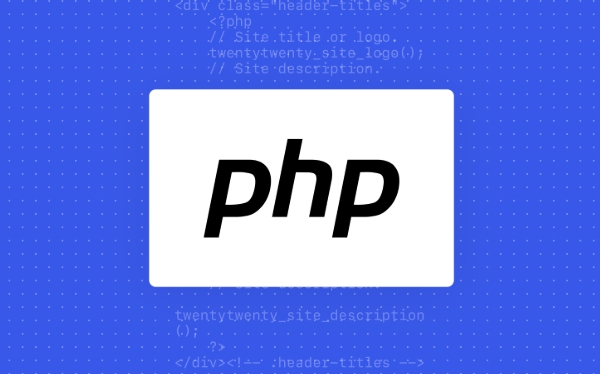There are three ways to implement deep copy of arrays in PHP: First, use unserialize and serialize to disconnect references by serializing and deserializing, which is suitable for ordinary and nested arrays; second, object arrays combine clone and recursive functions to flexibly process mixed types but ensure that the class supports correct cloning; third, json_encode and json_decode are suitable for pure scalar data, with simple writing but no resources or special objects.

When you process an array in PHP, you sometimes need to copy an array without affecting the original data. If you just simply assign values, you might get a shallow copy, especially when the array contains objects or multi-dimensional structures. At this time , deep copy is needed.

PHP does not have a special "deep copy" function, but similar effects can be achieved in several ways.

Use unserialize and serialize
This is the most commonly used and direct way:
$original = [ ['name' => 'Alice'], ['name' => 'Bob'] ]; $copy = unserialize(serialize($original));
- This method completely disconnects the relationship between
$copyand$original. - The principle is to serialize the array into a string first, and then deserialize it back, which is equivalent to reconstructing a new array.
- Suitable for most cases of normal and nested arrays.
What should be noted is:
This method fails if the array contains resource types (such as file handles); in addition, for objects, this method creates new instances, but may have side effects if the __sleep() or __wakeup() methods are defined in the class.

Object arrays can be recursive with cloning
If you have a lot of objects in your array and you want to really copy them deeply, you can combine clone and recursive functions:
function deepCopy($array) {
$result = [];
foreach ($array as $key => $value) {
if (is_array($value)) {
$result[$key] = deepCopy($value);
} elseif (is_object($value)) {
$result[$key] = clone $value;
} else {
$result[$key] = $value;
}
}
return $result;
}This method is more flexible and can also handle arrays of mixed types, but be aware of:
- If there are nested references or resources inside the object,
clonemay not be able to be completely copied; - It is necessary to ensure that the object class supports correct cloning behavior, otherwise it may still be a shallow copy.
Simple arrays can be used directly with json_decode and json_encode
If you are sure that the contents of the array are all basic types (strings, numbers, arrays, etc.), you can also try the JSON method:
$original = [1, 2, [3, 4]]; $copy = json_decode(json_encode($original), true);
The advantage is that it is simple in writing and can indeed disconnect quotations.
The disadvantages are:
- Resources or special objects are not supported;
- Formats such as time and date may be converted into strings;
- Integer keys will be automatically re-indexed (if it is an associative array, it is recommended to set to
trueas the second parameter).
To summarize the applicable scenarios:
- Ordinary array (including multi-dimensional) : the preferred
unserialize(serialize()) - Arrays with objects : consider custom recursive
clone - Pure scalar data : it is easier to use
json_encode/decode
Basically, these methods are all. Although PHP does not have a built-in deep copy function, these techniques can already meet most of the needs.
The above is the detailed content of how to deep copy a php array. For more information, please follow other related articles on the PHP Chinese website!

Hot AI Tools

Undress AI Tool
Undress images for free

Undresser.AI Undress
AI-powered app for creating realistic nude photos

AI Clothes Remover
Online AI tool for removing clothes from photos.

Clothoff.io
AI clothes remover

Video Face Swap
Swap faces in any video effortlessly with our completely free AI face swap tool!

Hot Article

Hot Tools

Notepad++7.3.1
Easy-to-use and free code editor

SublimeText3 Chinese version
Chinese version, very easy to use

Zend Studio 13.0.1
Powerful PHP integrated development environment

Dreamweaver CS6
Visual web development tools

SublimeText3 Mac version
God-level code editing software (SublimeText3)

Hot Topics
 php regex for password strength
Jul 03, 2025 am 10:33 AM
php regex for password strength
Jul 03, 2025 am 10:33 AM
To determine the strength of the password, it is necessary to combine regular and logical processing. The basic requirements include: 1. The length is no less than 8 digits; 2. At least containing lowercase letters, uppercase letters, and numbers; 3. Special character restrictions can be added; in terms of advanced aspects, continuous duplication of characters and incremental/decreasing sequences need to be avoided, which requires PHP function detection; at the same time, blacklists should be introduced to filter common weak passwords such as password and 123456; finally it is recommended to combine the zxcvbn library to improve the evaluation accuracy.
 How to combine two php arrays unique values?
Jul 02, 2025 pm 05:18 PM
How to combine two php arrays unique values?
Jul 02, 2025 pm 05:18 PM
To merge two PHP arrays and keep unique values, there are two main methods. 1. For index arrays or only deduplication, use array_merge and array_unique combinations: first merge array_merge($array1,$array2) and then use array_unique() to deduplicate them to finally get a new array containing all unique values; 2. For associative arrays and want to retain key-value pairs in the first array, use the operator: $result=$array1 $array2, which will ensure that the keys in the first array will not be overwritten by the second array. These two methods are applicable to different scenarios, depending on whether the key name is retained or only the focus is on
 PHP Variable Scope Explained
Jul 17, 2025 am 04:16 AM
PHP Variable Scope Explained
Jul 17, 2025 am 04:16 AM
Common problems and solutions for PHP variable scope include: 1. The global variable cannot be accessed within the function, and it needs to be passed in using the global keyword or parameter; 2. The static variable is declared with static, and it is only initialized once and the value is maintained between multiple calls; 3. Hyperglobal variables such as $_GET and $_POST can be used directly in any scope, but you need to pay attention to safe filtering; 4. Anonymous functions need to introduce parent scope variables through the use keyword, and when modifying external variables, you need to pass a reference. Mastering these rules can help avoid errors and improve code stability.
 How to handle File Uploads securely in PHP?
Jul 08, 2025 am 02:37 AM
How to handle File Uploads securely in PHP?
Jul 08, 2025 am 02:37 AM
To safely handle PHP file uploads, you need to verify the source and type, control the file name and path, set server restrictions, and process media files twice. 1. Verify the upload source to prevent CSRF through token and detect the real MIME type through finfo_file using whitelist control; 2. Rename the file to a random string and determine the extension to store it in a non-Web directory according to the detection type; 3. PHP configuration limits the upload size and temporary directory Nginx/Apache prohibits access to the upload directory; 4. The GD library resaves the pictures to clear potential malicious data.
 Commenting Out Code in PHP
Jul 18, 2025 am 04:57 AM
Commenting Out Code in PHP
Jul 18, 2025 am 04:57 AM
There are three common methods for PHP comment code: 1. Use // or # to block one line of code, and it is recommended to use //; 2. Use /.../ to wrap code blocks with multiple lines, which cannot be nested but can be crossed; 3. Combination skills comments such as using /if(){}/ to control logic blocks, or to improve efficiency with editor shortcut keys, you should pay attention to closing symbols and avoid nesting when using them.
 How Do Generators Work in PHP?
Jul 11, 2025 am 03:12 AM
How Do Generators Work in PHP?
Jul 11, 2025 am 03:12 AM
AgeneratorinPHPisamemory-efficientwaytoiterateoverlargedatasetsbyyieldingvaluesoneatatimeinsteadofreturningthemallatonce.1.Generatorsusetheyieldkeywordtoproducevaluesondemand,reducingmemoryusage.2.Theyareusefulforhandlingbigloops,readinglargefiles,or
 Tips for Writing PHP Comments
Jul 18, 2025 am 04:51 AM
Tips for Writing PHP Comments
Jul 18, 2025 am 04:51 AM
The key to writing PHP comments is to clarify the purpose and specifications. Comments should explain "why" rather than "what was done", avoiding redundancy or too simplicity. 1. Use a unified format, such as docblock (/*/) for class and method descriptions to improve readability and tool compatibility; 2. Emphasize the reasons behind the logic, such as why JS jumps need to be output manually; 3. Add an overview description before complex code, describe the process in steps, and help understand the overall idea; 4. Use TODO and FIXME rationally to mark to-do items and problems to facilitate subsequent tracking and collaboration. Good annotations can reduce communication costs and improve code maintenance efficiency.
 How to create an array in php?
Jul 02, 2025 pm 05:01 PM
How to create an array in php?
Jul 02, 2025 pm 05:01 PM
There are two ways to create an array in PHP: use the array() function or use brackets []. 1. Using the array() function is a traditional way, with good compatibility. Define index arrays such as $fruits=array("apple","banana","orange"), and associative arrays such as $user=array("name"=>"John","age"=>25); 2. Using [] is a simpler way to support since PHP5.4, such as $color






